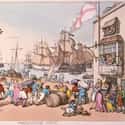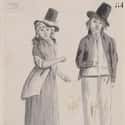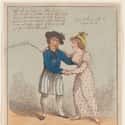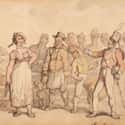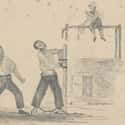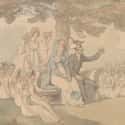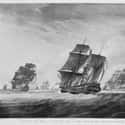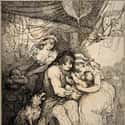-
(#1) Some Of The Passengers Sold Themselves At Ports En Route To Australia
The voyage to Australia lasted about 10 months, as the Lady Juliana voyaged from port to port in the Atlantic and Indian Oceans. The ship's stays in places like Rio de Janeiro and Cape Town could last several weeks. The convicts made the most of their global tour by selling their services in these ports.
As John Nicol, the ship's steward, euphemistically remembered, "We did not restrain the people on shore from coming on board through the day. The captains and seamen, who were in port at the time, paid us many visits."
The ladies kept at least part of their earnings. Some of the ship's officers and sailors allegedly even got in on the business, and their involvement raises serious questions about the degree to which these captive women were coerced into their activities.
-
(#2) Many Of The Ship's Sailors Took The Convict Women As 'Wives'
Whether out of love, lust, coercion, or necessity, many of the women on board the ship became the "wives" of the ship's officers and crew members. As the ship's steward John Nicol recalled in his memoir of the voyage: "When we were fairly out at sea, every man on board took a wife from among the convicts, they nothing loath."
While these marriages were not legal, they nonetheless served a practical purpose: taking a lover onboard the ship often meant better sleeping arrangements for the women. But at least one partnership was rooted in genuine feeling: Nicol seemed to have fallen in love with prisoner Sarah Whitlam. Though he intended to marry her once her term ended, the two never wed. Nicol had to go back to Britain, leaving Whitlam and their child behind in Australia. He attempted to reunite with her, but they never saw each other again.
Not all partnerships were as affectionate as Nicol and Whitlam's appears to have been. The lack of privacy for prisoners on convict ships meant that crew members had access to them, and their relations and interactions could be coercive. The age of consent in 18th-century Britain was 10 years old, so some crew members took teenage wives during the voyage. Historian Pamela Horn identified 14-year-old Jane Forbes as one such young wife - she had a baby before reaching Australia.
-
(#3) Colonial Officials Wanted The Women To Prevent Men From Sleeping With Each Other
There was not an even distribution of men and women among the convict-colonists in early British Australia. Of the 759 convicts sent to Australia aboard the First Fleet, 568 were men while only 191 were women. As a result, officials worried about how all those men would find partners - some were concerned that they would turn to one another.
To correct what 18th-century Britain perceived to be "gross irregularities" in romantic partnerships in Australia, officials begged for more women. In other words, the women of the Lady Juliana were meant to be sex objects and wives for male officers and convicts.
-
(#4) The Female Prisoners Were Expected To Civilize The Colony
The women of the Lady Juliana had a particular purpose: Colonial officials hoped that a shipload of women would help civilize the budding convict colony. According to one British official, the increased presence of women would "promote a matrimonial connection to improve morals and secure settlement."
They were to marry male colonists, which would supposedly create and maintain respectable family life in the new colony. The women's prison sentences aimed to transform them into moral vessels that would enable the re-creation of the British family unit abroad.
-
(#5) Most Of The Women Onboard The Ship Had Committed Petty Offenses
The women being transported to New South Wales on the Lady Juliana were prisoners, but their lives were upended for infractions that appear minor in the 21st century. Though some of the women aboard the Lady Juliana might have been ladies of the night, that's not why they were sent to Australia - harlotry was not a transportable offense. Most of the women on the ship had been arrested and sentenced for various degrees of theft.
Their offenses ranged from highway robbery to shoplifting and pickpocketing. Mary Hook, for example, was around 20 years old when the British court commuted her punishment for stealing her employer's money and goods from capital punishment to a seven-year sentence in New South Wales.
As the ship prepared to depart, a small group managed to escape. Being sent to the other side of the world may have been preferable to more severe penalties, but it was nonetheless a terrifying experience for many women; some left England with heavy hearts as they were ripped away from friends and family. They worried about their uncertain future on a new continent.
-
(#6) Elizabeth Barnsley Became An Enterprising Madam Aboard The Ship
One of the most notable convicts on the ship was Elizabeth Barnsley. Her offense: stealing some cloth. She quickly became a leader during the voyage. As John Nicol, steward of the Lady Juliana, recalled, "She was very kind to her fellow convicts, who were poor. They were all anxious to serve her. She was as a queen among them."
Barnsley made the most of her circumstances and turned her position into profits - she was instrumental in overseeing her fellow convicts' economic activities at every port along the way.
-
(#7) Some Of The Women Might Have Been Sex Workers In England
Though they were not being transported to New South Wales for prostitution, many of the women aboard the Lady Juliana may have been ladies of the night. A robust harlotry economy existed in 18th-century Britain, so it's reasonable to assume that some of the 200-plus convicts took part.
Moreover, many of the passengers' stories fell into the "fallen woman" trope that had become popular in novels and plays. John Nicol believed many of the women had been seduced at some point in their lives. He wrote about how Sarah Dorset, for example, had "fallen" into a life of alleged folly and sin:
She had not been protected by the villain that ruined her above six weeks; then she was forced by want upon the streets, and taken up as a disorderly girl; then sent onboard to be transported.
-
(#8) The Lady Juliana Provided Better Living Conditions Than Other Convict Ships And British Prisons
The women aboard the Lady Juliana came from British prisons. Though a prison reform movement began to grow in the late 18th century, the prison conditions they escaped were deplorable. Prisons were overcrowded, and diseases spread swiftly.
It was still a prison ship, and most of the passenger-convicts slept just above the ship's garbage and sewage deck. But the women of the Lady Juliana had something that their land-imprisoned counterparts didn't: consistent access to medical care. The ship had a surgeon and was kept relatively clean.
Also, the women weren't chained up like prisoners on other convict ships, and they could barter for improved conditions through various favors. John Nicol credited the ship's captain with being "a humane man" who "did all in his power to make the convicts as comfortable as their circumstances would allow."
Part of the reason the passengers on the Lady Juliana enjoyed better conditions was because the British government oversaw it, unlike the other ships in the Second Fleet. All the other vessels were operated by Camden, Calvert, and King, a notorious and prolific slave trading company. Only five women perished aboard the Lady Juliana, compared to the 267 deaths reported by the other ships.
-
(#9) About 1 In 5 Of The Passengers Was A Teenager
The vast majority of the women who embarked on the Lady Juliana were in their 20s and 30s. But no fewer than 51 of them - or around 22% - were teenagers. Mary Wade was one of these. Though scholars debate her exact age - recent research says she was 13, while earlier records show she was only 11 - she was the youngest convict on the ship.
Like many of her shipmates, Wade ultimately married and had a large number of children in Australia.
-
(#10) Drunkenness Was The Biggest Disciplinary Problem On The Ship
Though it took the Lady Juliana nearly 11 months to reach Australia, there were relatively few disciplinary problems among the convicts on the ship. One notable issue did arise involving drunkenness leading to disorderly behavior.
To curb her so-called "rowdiness," crew members made passenger Nance Ferrel wear a repurposed wooden barrel "jacket." When that didn't work, they resorted to flogging her 12 times.
-
(#11) Many Colonists Were Annoyed When The Ship Arrived Carrying Women Instead Of Provisions
The First Fleet of convict-colonists arrived in 1788. So by the time the Lady Juliana sailed into Sydney in June 1790, the people already there were desperate to replenish their severely dwindled supplies. Many of them were disappointed to learn the Lady Juliana was a ship carrying people, not goods. One government official grumbled that the Lady Juliana carried "a cargo so unnecessary and so unprofitable as 222 females, instead of a cargo of provisions."
Though the ship didn't bring much in the way of food and goods, it did bring long-awaited news from home, such as dispatches that first alerted the colonists in Australia to the French Revolution that had erupted in 1789.
-
(#12) The Women On The Ship Had To Wear Convict Dresses
As prisoners, the women going to Australia on the Lady Juliana were expected to wear convict dresses. At least one fashionable prisoner protested this. According to the ship's steward, Elizabeth Barnsley actually "petitioned the government agent and captain to be allowed to wear her own clothes" while the ship prepared to sail. Her request was denied, but the crew allowed her to wear whatever she wanted once the boat went to sea.
Since the convicts all wore issued dresses, the ship's captain had the right to dispose of all the passengers' clothing - but he didn't, and instead held it for them. He reasoned that the garments "would be of use to the poor creatures when they arrived at Port Jackson."
-
(#13) Some Of The Women Brought Their Children, And Others Gave Birth On The Way
Some of the women aboard the Lady Juliana were already mothers before the ship departed England, and so they brought their children with them. Many of the convict-passengers became pregnant and even gave birth during the long voyage.
Historians generally believe five to seven babies were born on the ship, but steward John Nicol suggested no less than 20 had been born while the ship was in port at Rio. They were prepared for the births - the ship had received a small donation of baby linens before leaving England.
-
(#14) Life In Australia Brought New Freedoms And Opportunities For Some Of The Passengers
Unlike other convicts on prison ships, the women aboard the Lady Juliana were not chained together. They were even allowed to move freely around the boat. And once they arrived in New South Wales, they quickly discovered they could enjoy new freedoms there that they couldn't in England, even though they were prisoners with few rights who were put in difficult and often dangerous positions.
Women arriving in Australia were free from certain British moral codes, even while colonial officials expected them to be vessels of morality. English laws that marked children of unwed mothers as illegitimate, for example, were not enforced.
The women of the Lady Juliana were also fortunate in that they avoided the fate that awaited future generations of convict women bound for Australia - the notoriously brutal Parramatta Female Factory didn't open until 1821, well after their sentences ended.
Though being transported to a new colony to get married and propagate British family life was no doubt daunting, many women made the most of their circumstances in Australia. In the late 18th and early 19th centuries, the Australian colonies were societies on the rise - and they created new opportunities. Some Lady Juliana passengers became upwardly mobile once their prison terms ended.
While some returned to England, others remained in Australia to make their fortune. Ann Marsh, for one, found success after being abandoned by her ship husband. She started and ran a variety of businesses, including a liquor shop and a ferry company. These women had a lasting impact on the land, becoming the so-called "founding mothers of Australia."
New Random Displays Display All By Ranking
About This Tool
In 1787, Britain began to colonize Australia. The British government licensed the lady Juliana to transport nearly 300 prisoners to Australia. Most of the prisoners on this ship were London prostitutes, and some ordinary criminals, such as thieves and shoplifters. The prisoner ship "Lady Juliana" arrived in Sydney in the winter of 1790. It was one of the slowest prisoner ships in history.
The unbelievable thing is that most of the women were pregnant when they landed, because almost every man on this ship had sex with female prisoners, and many had already given birth to children at sea. The lady Juliana was also famous for the "mobile brothel". The random tool brings us to know 14 wild stories of the lady Juliana.
Our data comes from Ranker, If you want to participate in the ranking of items displayed on this page, please click here.











